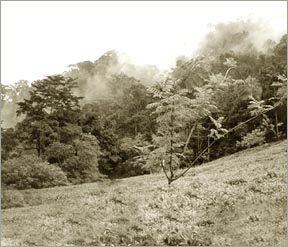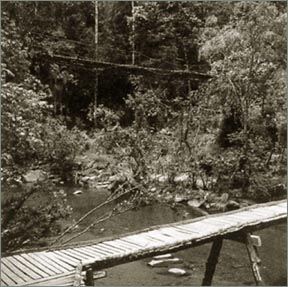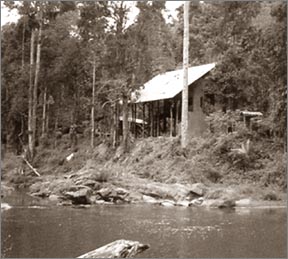|
observer |
|
|
|
|
|
OTHER LINKS |

|

|

|
A village in Sinharaja
Our guides for the trek were two villagers from Wathugala, petite Samantha, 18, and her brother who was seven. They were very amused at our attention to footgear, namely sock, shoes and leech repellent, as this was a trek they made so often. We were keen to learn about the native life style of the isolated villagers and this, we knew, could be best achieved if we stayed overnight with the inhabitants. On our long walk, the only place where we stopped was at the official entrance to the Sinharaja Forest. The chirping of birds, the call of the wild and the endless gushing of streams enveloped us in nature as we walked. When we arrived at the footbridge across the Kiriweldola River, Samantha seemed sorry we would miss the chance to cross the river using the suspension bridge (Sangili Palama), as floods and strong winds had damaged it.
We continued our journey through narrow gravel footpaths embedded with roots of trees, stones and logs which made natural steps. We traversed through golden green paddyfields, passing wattle and daub houses that have encroached on the jungle. Since this was a footpath often used by the villagers we didn't encounter any animals. As we hiked, Samantha told us she took this long walk on her own through the forest every time she returned home for the weekend. She enjoyed the magnificent view from the bridge, where the river and the thick jungle on either side narrowed down at the far end, making it seem like the end of the river's journey. After our long and weary walk, Samantha's house situated at the top of the mountain was almost like "mission impossible'. With the greatest difficulty and totally out of breath we made it to the top.
Lunch turned out to be another learning experience. We were served rice with potato curry and felt kind of disappointed about having come all the way to Sinharaja to be served common potato curry. However, we were shown a bunch of plantain and told this fruit when raw is used as a vegetable and when ripened is a delicious dessert. We had the good fortune of tasting both versions. The trip after lunch was even more adventurous than before. This time our guides were Samantha and her father. Together we waded across the river's cool waters which soothed our tired feet. Unpolluted and crystal clear the water was tempting enough for a cool dip.
On the way back we bathed in the Gin Ganga at a place where two rivers meet: the Gin Ganga, which flows down from Kurulugala, and the Araluwa Ganga which flows down the Gonagala Mountain. It was amazing to discover that one river carried cold water and the other warmer. At the point they met, the temperature difference was significant enough to make one hesitate to cross over to the colder area. It is a rare privilege for villagers and visitors to take hot and cold baths in the same spot, amidst the most beautiful natural habitat.
They also cleverly generate hydro-electricity, and the people of the village share it on a controlled basis. Each household is allowed to use only 100 volts, (which means four 25 volt bulbs or any other combination). On a given day the whole village is allowed to use two smoothing irons, and in case of celebratory functions the others willingly forgo their electricity usage. This is the very essence of sharing and caring and true goodwill and amity. Though the installation of the turbine itself was assisted, the present management is purely self-governed by the village committee, diligently carrying out its task of supplying power to the village. It was refreshing to observe the familiarity of the villagers by the manner they greeted each other whenever their paths crossed and inquired about the welfare of each other's loved ones. After visiting Wathugala and staying with the indigenous people of the village, I realised how rich they are in human qualities and have become envious of their naturally uncomplicated lifestyle. Courtesy Explore Sri Lanka |
 Wathugala is a remote village in the South Western Province of Sri
Lanka. To reach it we walked for over three hours through the thick,
dense greenery of the Sinharaja forest from where the road ended at
Mederipitiya, after passing Pallegama via Deniyaya.
Wathugala is a remote village in the South Western Province of Sri
Lanka. To reach it we walked for over three hours through the thick,
dense greenery of the Sinharaja forest from where the road ended at
Mederipitiya, after passing Pallegama via Deniyaya.  The new wooden bridge built by the villagers looked steadier although
I wondered how long it would last and what would happen about access if
floods took that too.
The new wooden bridge built by the villagers looked steadier although
I wondered how long it would last and what would happen about access if
floods took that too.  Samantha's parents welcomed us warmly as though we were family
returning home after years away. Tea was served in clay cups, along with
helapa, a steamed confection dessert made out of Kurakkan flour and
crushed Beraliya nut wrapped in a leaf. The Beraliya fruit is used as a
drink similar to coffee, to cook as a vegetable, ground to make flour or
as medication. It was an absolute treat.
Samantha's parents welcomed us warmly as though we were family
returning home after years away. Tea was served in clay cups, along with
helapa, a steamed confection dessert made out of Kurakkan flour and
crushed Beraliya nut wrapped in a leaf. The Beraliya fruit is used as a
drink similar to coffee, to cook as a vegetable, ground to make flour or
as medication. It was an absolute treat.  Down stream was silent and lonely and we tried to do some bird
watching. However, we were disturbed at intervals by leeches but we
followed Samantha's good advice of carrying a pouch containing soap,
lime and salt, and applied that to make them drop off.
Down stream was silent and lonely and we tried to do some bird
watching. However, we were disturbed at intervals by leeches but we
followed Samantha's good advice of carrying a pouch containing soap,
lime and salt, and applied that to make them drop off.  According to Samantha's father, the source of revenue of the
villagers is tapping kitul palm trees and producing jaggery. They also
own land on which tea is cultivated. Income generated from these
occupations is sufficient for them to make purchases such as rice and
other essentials and still be self-contained.
According to Samantha's father, the source of revenue of the
villagers is tapping kitul palm trees and producing jaggery. They also
own land on which tea is cultivated. Income generated from these
occupations is sufficient for them to make purchases such as rice and
other essentials and still be self-contained. 









